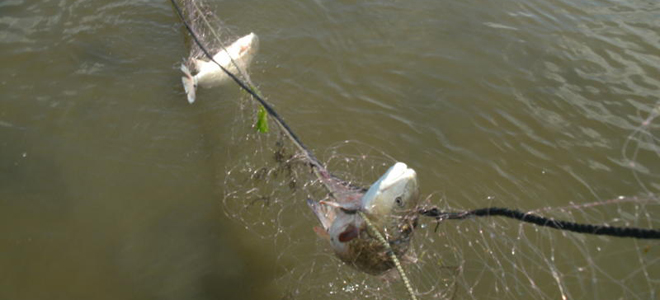
NCDMF orders all large-mesh gill nets out of inshore waters by Monday
Banned from selling red drum until at least September because of overharvest, commercial fishermen in North Carolina requested on Tuesday that the N.C. Division of Marine Fisheries reopen the commercial season on a limited basis after taking nets out of the water for the rest of May. They got half their wish today, when NCDMF’s director said he would close all internal waters to large-mesh gill-netting for all species on Monday for at least the next month because of the possibility of reds being caught in nets and discarded. But Dr. Louis Daniel also said Friday there is no chance of re-opening the commercial harvest or reds until at least Sept. 1.
The N.C. Fisheries Association, a trade group representing commercial fishermen, had requested that Daniel remove large-mesh gill nets from the water until June 1, then use his power of proclamation to reopen the commercial red drum season on a limited basis, even though netters exceeded their catch allowed through Aug. 31 by more than 13,000 pounds in barely three months last fall.
The group’s request cited a lack of diligence by NCDMF in monitoring the catch and overage and said electronic reporting should be required on a weekly basis; this same group has lobbied in the past to prevent this requirement, saying that small fish houses in rural areas without internet and computers could not file these reports without incurring burdensome expenses.
Daniel immediately replied to the commercials’ request by saying that it was not in NCDMF’s power to reopen fishing if a seasonal quota set by federal fisheries managers is exceeded. The next day, he closed the entire large-mess gill-net fishery until June 1 – when many areas could begin to close if incidental take of endangered seas turtles is too great.
“There is a red drum stock assessment scheduled for next year by the (Atlantic States Marine Fisheries Commission),” Daniel said. “Once that is in place and has been reviewed and approved, and the Science and Statistical Committee has added their recommendations, we can incorporate that data and possibly amend the fishery management plan. (Our) fishery management plan review will follow that, but it will be at least two years before anything could be changed, and then only if the stock assessment supports it.
“Re-opening red drum before Sept. 1 would result in non-compliance with the North Carolina and Atlantic States Marine Fisheries Commission plans,” Daniel said.
The NCFA asked NCDMF for a May 1 closure of the large-mesh gill-net fishery in its request, but it wanted Daniel to open the fishery on June 1 in certain areas of the coast, including portions of Albemarle Sound, the Pamlico River, and the Bay, Neuse and New rivers, with commercial netters allowed to sell four red drum per day. It also asked for a daily commercial limit of seven red drum in other areas at a later date, and that strike nets and drift gill nets be exempted from certain restrictions.
The state’s Red Drum Fishery Management Plan mandates a commercial year that begins on Sept. 1 and ends on August 31 and has an annual 250,000 pound cap on commercial landings. That is further divided into a fall-winter season that begins on Sept. 1 and ends on April 30 and a spring-summer season that begins on May 1 and runs to Aug. 31. The 250,000-pound annual catch is divided into 150,000 pounds for the fall-winter season and 100,000 pounds for the spring-summer season. The Fishery Management Plan further states that this is to be a by-catch fishery with no directed effort and that any overages in catch must be paid back in the next season.
The problem arose when commercial fishermen landed slightly more than 263,000 pounds of red drum during the first 84 days of the 2013-2014 fall winter season. The provisions of the plan require the season to be closed and not reopened until at least Sept. 1, 2014, when the 2014-2015 commercial season begins. The 13,000-pound overage for the year must be deducted from the 2014-2015 season.
CCA-North Carolina responded to the NCFA request with a written statement stating, “CCA NC thinks the NCFA request to re-open the commercial harvest of red drum is absurd. The commercial industry not only met their annual quota but exceeded it. In fact, the Fall/Winter season was exceeded by almost 75 percent. We believe everyone realizes that targeting of red drum occurred and will likely continue.
“CCA feels serious consideration should be given to a decrease in the number of red drum that can be kept as commercial by-catch AND southern flounder should be the only fish serving as the target species. This combination has history and has proven to work in decreasing red drum by-catch. That said, the absolute best solution would be for the state fish, the red drum, to be designated a gamefish and off-limits to commercial sale.”
The N.C. Marine Fisheries Commission will discuss future management of red drum at its May 21-13 meeting.




Be the first to comment